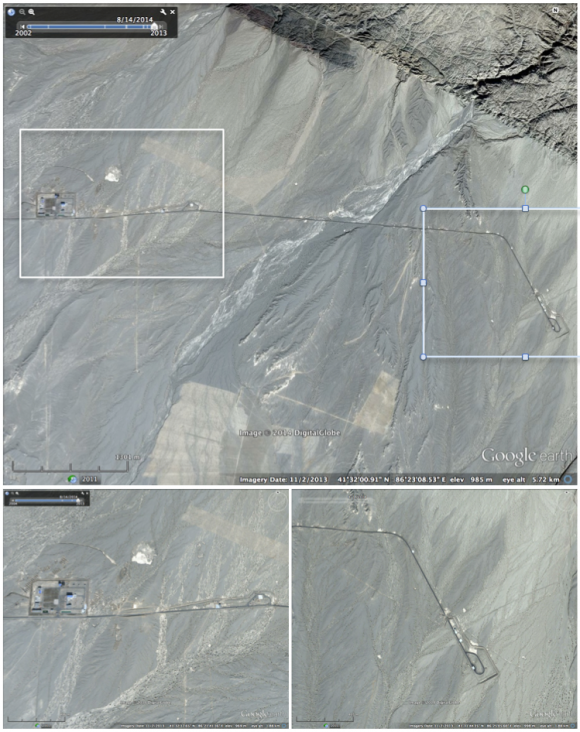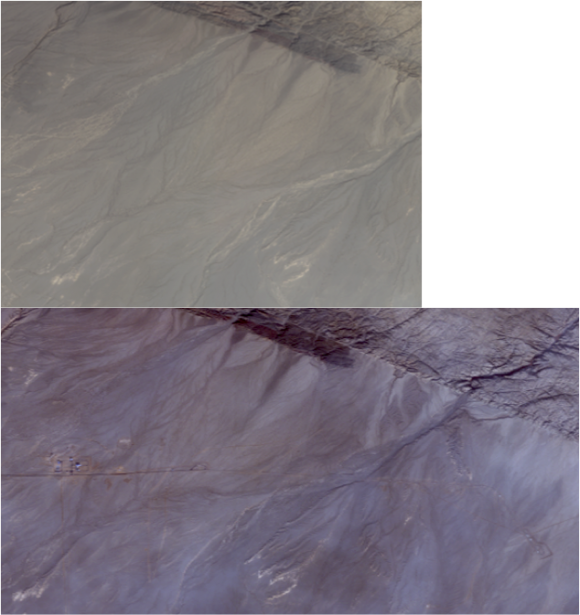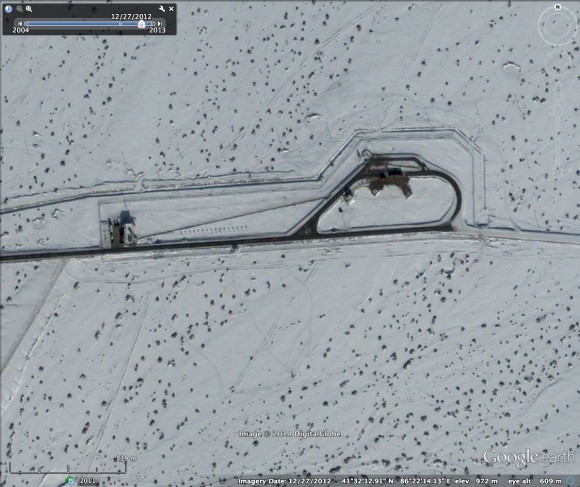I have a new column at Foreign Policy, as well as a podcast with Aaron Stein, on China’s testing of hit-to-kill technologies against satellites and ballistic missiles. I’ve been trying to figure out where Arms Control Wonk fits in between my columns for Foreign Policy and 38North, on one hand, and Twitter on the other. Stuff like this I guess.
One detail that has cause confusion is the so-called “Korla Missile Test Complex.” According to a State Department cable released by Wikileaks, China conducted the January 2010 missile defense test using an interceptor fired from Korla. There are no previous open source references to this site. (Those cables are located here and here.)
I was going to find the site. Chinese language blogger “KKTT” beat me to it. KKTT identifies a site located at 41°32’16″N 086°22’19″E as the Korla Missile Test Complex. I believe that is correct. It is close to the Chinese city of Kù’ěrlè (库尔勒) or Korla.
You can get a good look at in Google Earth. The site has three main areas: a support base and two launch pads — I’ll call them A and B.
A few points.
First, I looked through catalogues of satellite imagery. China constructed the base between March 16, 2009 (no base is visible) and the November 27, 2009 (all major features are visible.) Here is a pair of images from March and December 2009. That would suggest the site was purpose built for SC-19 testing. That’s probably why we haven’t heard about it before. It’s new.
Second, I checked the Digital Globe/GeoEye catalogue against the dates of the possible launches from Korla. There is an image from January 27, 2013, which will almost certainly show the SC-19 on the pad. (As a nice little detail, other images from January 2013, just before the test, show one of the launch pads has been plowed clean of snow, presumably in advance of the test. We’ll probably order the January 27, 2013 image. Someone should check Astrium. (My plug-in is crashing.) Here are the dates for which I looked: January 11, 2010; September 25, 2010; January 27, 2013; and July 23, 2014.
Note that the September date is inferred from NOTAMs. I can’t find a decent historical database of Chinese NOTAMs, but I bet that might reveal a few more launches from Korla. A picture of the site from September 25, 2010 might confirm that a test occurred.
In the meantime, here is snow clearance a few days before the January 2013 launch at Launch Pad A. Launch Pad B is buried in snow.
Third, I don’t know who runs the site. It is probably the General Armaments Department, but I don’t see any open source references in sources like the Directory of PRC Military Personalities to missile test facilities near Korla. If the Korla Missile Test Complex is a GAD facility, then I would expect it to have a base number in the 30s unless it is attached to an older, existing element. I am not sure whether personnel live elsewhere near Korla or deploy for short periods of time.
Update | 11:08 am PST There are a bunch of other interesting sites around Korla that I didn’t mention. Sean O’Connor identifies more in a piece for Jane’s that I had missed. I’ll further update when he has a chance to send the stuff along.




Further support for the conclusion that Korla was purpose built for SC-19 testing is that its construction appears to come AFTER the 2007 test which came from the NW pad at Xichang.
Hypothesis:
The first launch of the rocket was from Jiuquan (Shuangchengzi, hence the US labeling the system “SC”. At some point the testing moved to the NW mobile pad at Xichang. Not sure I can think of a good reason why to move to Xichang – perhaps there was better range instrumentation? Perhaps because they knew it would be going to several hundred km, much higher than normal ballistic missile testing, and felt they could better mask the activity at a space launch center?
The July 2005 test may have been from Xichang but it’s unclear as the Google Earth imagery only show it being built at some point between April 9 and November 6. It’s likely that the Feb 2006 test was from that same pad, and we know that the Jan 2007 was from there as well.
Then they took a three year pause to the testing program as a result of the international criticism after the 2007 test. It also appears that they chose to built the complex at Korla and move the testing there. Perhaps the logic was that by moving it to Korla (as opposed to a space launch facility at Xichang) and testing against a ballistic target they could plausibly call it “missile defense” testing.
This makes me curious what the plan will be for the new system tested in May 2014. As I pointed out in my analysis, I looks like they built a new pad to the SE in Xichang for this test. Why do that instead of launching it from Korla? Perhaps the reason is the altitude – it’s not plausible to have a “missile defense” interceptor going up to tens of thousands of km, thus the need to characterize it as a “sounding rocket” and scientific test.
I wonder whether or not any further testing of that system will continue from Xichang, or whether there will be a shift to Korla as well. My guess is it would have to be from a space launch facility.
> Why do that instead of launching it from Korla[?]
Just a guess, but it would be useful to have a number of available ASAT launch sites spread out in longitude (east to west) to give rapid and repeated access to targets in polar-ish LEO orbits. The ground tracks of such orbits march about 22 degrees west rev-to-rev, so having two or three or four launch sites spaced across China would afford multiple engagement opportunities in the space of a few hours.
For Korla, FWIW, see http://thetaiwanlink.blogspot.com/2010/01/chinas-missile-defense-interceptor.html
Note the apparent radar 16 km to the northwest, at 41.6413 N, 86.2369 E.
Link to a zoomed-out version of the map from the KKTT blog:
http://upload.tennyy.com/upload/321406274818.jpg
Both Rose Gottemoeller and Frank Rose both slammed the PRC for ASAT testing in prepared remarks at STRATCOM’s Deterrence Symposium this week.
MK
Rose G’s remarks:
“My colleague, Deputy Assistant Secretary Frank Rose spoke about strategic stability in space yesterday, highlighting the point that it is essential that all nations work together to adopt approaches for responsible activity in space in order to preserve this domain for future generations. China’s recent irresponsible and provocative ASAT test accentuates the importance of these efforts. Russia’s pursuit of anti-satellite weapons is also a matter of concern. Destabilizing actions like these threaten the long-term security and sustainability of the outer space environment.”
and this from Frank R:
“On July 23, the Chinese Government conducted a non-destructive test of a missile designed to destroy satellites in low Earth orbit. Despite China’s claims that this was not an ASAT test; let me assure you the United States has high confidence in its assessment, that the event was indeed an ASAT test.
And China is not the only one pursuing these capabilities. As Director of National Intelligence James Clapper noted in his February 2014 congressional testimony, “Russian leaders openly maintain that the Russian armed forces have antisatellite weapons and conduct antisatellite research.”
The United States believes that these activities, which include the continued development and testing of destructive anti-satellite systems, are both destabilizing and threaten the long-term security and sustainability of the outer space environment. A previous destructive test of the Chinese system in 2007 created thousands of pieces of debris, which continue to present an ongoing danger to the space systems—as well as astronauts—of all nations, including China.
Debris-generating ASAT weapons present a host of threats to the space environment that threaten all who benefit from outer space: the civil, commercial, military and scientific space endeavors of all nations. On the security side, ASAT weapons directly threaten individual satellites and the strategic and tactical information they provide, and their use could be escalatory in a crisis. They also present a threat to key assets used in arms control monitoring, command and control and attack warning. The destructive nature of debris-generating weapons has decades-long consequences as well: they can increase the potential for further collisions in the future, which only create more debris. A debris forming test or attack may only be minutes in duration, but the consequences can last decades threatening all space systems. It is for these reasons that the United States believes testing debris-generating ASAT systems threaten the security, economic well-being, and civil endeavors of all nations.”
Jeffrey, what do you think about the recent DF-41 news?
What’s the recent DF-41 news? I think the Chinese are developing a new ICBM larger than the DF-31A and that it might even be called the DF-41. I think I’ve seen the TEL on the road.
This one.
http://www.telegraph.co.uk/news/worldnews/asia/china/11005061/China-confirms-new-generation-long-range-missiles.html
In the image of 12/27/2012, snow does not seem to have been cleared but shows a used road surface. The pad has a TEL and we can also observe some other vehicles with radars and/or other instruments. The pad however, is empty on 1/9/2013.
You have not discussed the second pad?
The possibility of any major test taking place in 1/2013 or before is very remote.
The test on 7/23/2014 is not likely to have been carried out from this location.
I mentioned both pads — A and B. B is snowbound.
I’ll take a second look, but it looks like snow clearance to me. I think I see berms where the snow has been plowed.
Why do you say the possibility is remote?
Firstly the imagery for 7/11/11 is same as 5/14/14 on GE.
It actually is dated 5/14/14. Wonder if it is done purposely.
Look at this instrumentation pad at 41 32 34 86 23 24 and the other two also.
They do not show any activity on 5/14/14.
The admin area seen on 12/27/12 and 1/9/13 has different snow clearance signatures. I am including all manual, machines as well as by routine usage when I mention snow clearance.
Vehicular activity observed at the base on 12/27/12 is more than on 1/9/13 but snow clearance is tells a different story.
The construction of a new high bay garage is a significant addition in the latest imagery. The tree line too is confusing.
The second pad “under snow” has activity on 6/3/11 and 7/11/11.
But a careful image comparison of both days shows no activity at all. All the vehicles are standing in exactly the same position on both days.
There are many significant signatures suggesting IMHO, that the site is not in actual use.
It could possibly be in use for testing other missiles requiring less preparation.
Corroboration will require higher temporal resolution and correct dates on GE imagery.
BTW, KKTT’s link gives different timings and locations than what is known or perceived to be known as correct.
I don’t see any 5/14 imagery in google earth.
The site is not the main base, but rather a location to which the troops from the main base located elsewhere in Korla deploy for launches.
Put the historical imagery icon off.